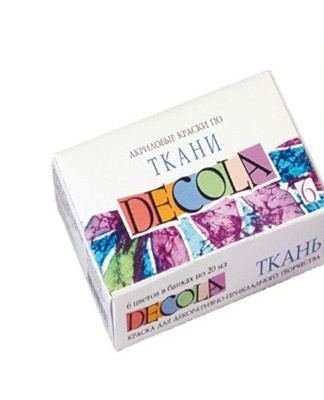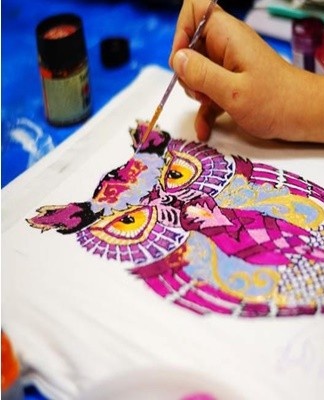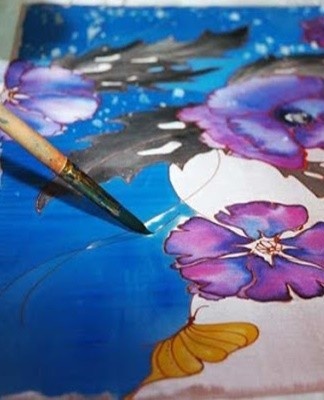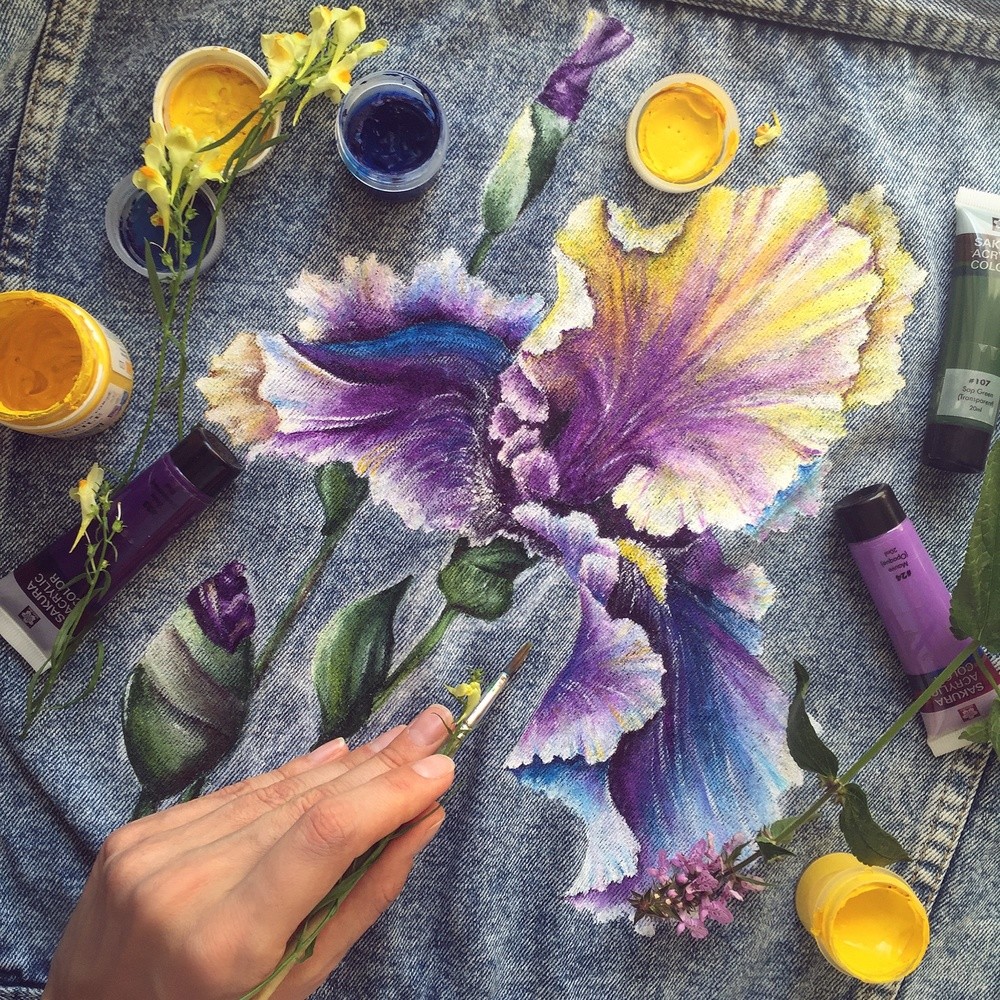Drawings with acrylic paints on fabric for beginners and the 6 best painting technologies
Many housewives more than once had a desire to paint their own or children's clothes in bright colors. Today, this is not a problem: there is a wide range of acrylic paints on the market. Choose the right materials, prepare your clothes, be creative, and you will obtain a magnificent result. There are several acrylic painting techniques that allow you to create bright and interesting images that no one else will have.
Content
Painting fabrics with acrylics: advantages and disadvantages
Acrylic is the best polymer dye for clothes. When painting, the pigments do not seep into the fibers, but remain on the surface, forming a film. The dyed surface of the fabric becomes denser and less elastic. Acrylic paint allows you to create bright, multi-colored and waterproof images on clothes. The palette is rich, the colors can be mixed to create additional shades.
High safety requirements are placed on acrylic paints for fabrics.They are made from environmentally friendly components that do not smell or cause an allergic reaction.

Acrylic is ideal for beginning crafters.
What fabric is good
Humidity is not terrible for acrylic filler, you can paint all wardrobe items and fabric accessories: jeans, t-shirts, bags, jackets, umbrellas, raincoats, scarf. You can also make beautiful panels for wall decoration, napkins and tablecloths for the festive table.
Do not paint with acrylic paint only:
- bedding (due to frequent washing, the color will quickly fade);
- underwear (constant rubbing against the skin can cause an allergic reaction);
- things that need to be taken for dry cleaning;
- clothes for babies and toddlers (paint can be an allergen for a child's fragile body).
When choosing a paint, consider the relevance of the type of fabric. To do this, look at the marking on the container with the dye:
- "Silk" - this inscription on the pot indicates that the dyed fabric is not particularly thick, so even thin things can be dyed: silk, cambric, chiffon.
- "Textile" - the label indicates that the ink is optimal for dense fabrics. It can be used for painting furniture, even leather and suede products.

Preparatory steps before drawing
Acrylic paint is meant to be applied to a clean cloth. Therefore, before painting, clothes should be thoroughly washed, held in cold water for about an hour, thoroughly dried and ironed with an iron. It is best to hang silk or other thin fabric in the straightened state on a crossbar, let it dry completely.
When performing some dyeing techniques, craftswomen use a self-made hoop or frame. But usually it is not necessary to stretch the material too much, laid on a flat and solid horizontal surface, it will paint well. Paint with acrylics in a well-lit room.
Choosing the right acrylic dye for dyeing fabrics is important. Available in light and dark fabric backing paints. If the canvas is dark, it is advisable to apply a light primer before applying the acrylic.
Acrylic paints are sold in cans, cans, tubes. The most demanded products are those of the manufacturers Decola, Marabu, Dylon, Simplicol. The products include, in addition to the paints themselves, auxiliary materials:
- brushes;
- solvents to adjust the dye density;
- fabric pencils;
- compositions for creating outlines;
- stencils.
Acrylic paint technology
Painting the fabric with acrylic paint is a batik.The peculiarity of the paint is that a fixing compound is used to obtain a delimiting contour at the junction of two pigments.

The basis for dissolving acrylic paint is water, but many craftsmen prefer to use special solvents. When using water, the image is dull when using solvent - shiny. To fix the pigment, you need to step on the dried canvas with an iron.
hot batik
The hot batik method is used for painting natural dense fabrics: linen, cotton, jeans, viscose. Melted wax is used to create a multi-colored image with clear outlines. Underneath the lines of wax applied to the fabric, white or another original color of the material remains.
To apply the wax, you need to use the singing tool - a pen with a small container and a writing tip. Before starting work, you need to melt the wax.
For a beginner, you can take a wax candle to practice. Experienced craftsmen make the material themselves - from paraffin, fat, dammar, beeswax, pine resin.
Work algorithm:
- Select an image. Transfer it to the fabric using tracing paper or another method.
- Cover areas of the image that should not be painted, cover with melted wax. Allow to dry completely.
- Paint on the canvas with acrylic dye. Wait until it is dry.
- Remove the wax coating with the help of paper, heating the cloth through it, gently peeling off the mass.
- If necessary, cover other areas with wax, repaint the canvas in a different color.
cold batik
The method differs from hot batik by using not wax, but a special composition called resist.Therefore, the technique is called redundancy in another way.

The working algorithm, in general, is the same: with a composition that does not let paint through, cover the necessary areas of the fabric, and then paint the free part of the canvas. Once the acrylic has dried, remove the outlines from the backing. The result is a multicolored image with clear outlines. The cold technique is optimal for creating stencil designs.
batik knot
The technique allows you to create original abstract patterns with unusual color transitions. Optimal for creating original T-shirts, sundresses, tablecloths, napkins. Easy to make, recommended for beginner crafters.
First, roll small knots into the fabric. Then you need to paint as follows:
- Paint over the background if necessary. Dry the product.
- Put small stones or buttons in arbitrary places on the canvas. Roll in knots.
- Fold the canvas itself in several layers, twist it arbitrarily, tie it with threads to form a tight mass.
- Dip into a bowl of paint, hold for a while.
- Take out, dry, smooth.
Free painting
The technique is suitable for experienced craftsmen with artistic abilities. This is a common image creation without the use of stencils. The artist can paint any picture, showing maximum imagination and skill.
To prevent the acrylic paint from spreading, the fabric should be immersed in a saline solution for 2 hours. It is permitted to use a reserve agent; in its absence, a primer is required. To make it, mix equal parts PVA glue, starch and gelatin, apply with a brush to the area to be painted, wait for it to dry completely.
Loose paint is wet when acrylic is applied to a damp cloth without using a stencil.Colors mix, merge into each other, a blurry, airy, watercolor-like image is obtained.

Air-brush
This acrylic painting technique also requires artistic skills. To paint the fabric, you need to purchase an airbrush - a special type of spray gun for comfortable distribution of paint at a distance of 20-30 cm from the canvas. By moving in and out of the device and changing the spray angle, you can create interesting effects and different shades.
shibori technique
The Japanese technique is a kind of nodular. Only the fabric is not tied, but twisted and folded in different ways according to the principle of folding origami paper. What the drawing will be, the master does not know until he unfolds the dried canvas.
Interesting ideas for author works
Anyone can create beautiful acrylics. Even a child can learn to dye fabrics: he will have something to do without distracting his mother from household chores. Creating acrylic paintings is an extremely exciting activity, you only have to try it once to really get carried away. Fortunately, ideas abound.
Create fashionable clothes and accessories for the whole family with your own hands, decorate the interior. Acrylic painted curtains, decorative pillows for sofas, wall panels, tablecloths and interior curtains look great.
Mix batik techniques. For example, complete the stencil technique with an airbrush by working from a distance: you will get beautiful splashes. Decorate ready-made paintings with beads, beads, sequins, decorative stones.For clothes of a certain style, choose suitable sketches: ethnic ornaments, mandalas, cult symbols.

Useful tips for beginners
For successful fabric dyeing with acrylic dye, follow these guidelines:
- Buy acrylic paints at specialized outlets. Remember that a cheap dye is probably a fake.
- Don't buy paint with an expiration date.
- Carefully read the composition on the container. High-quality acrylic dye does not contain toxic substances and heavy metals, does not have a specific smell.
- Paint a small area with acrylic before starting work. Check the result when the fabric is completely dry.
- Apply each subsequent coat when the previous one is completely dry.
- Fix the painting with an iron 24 hours after painting. Iron on the wrong side for at least 5 minutes. Heat the iron as needed for the fabric.
- First, paint with light paint. Put dark tones on top.
- Using the stencil technique, it is more convenient to dye the fabric with a foam rubber stamp. To keep your fingers clean, it should be attached to a comfortable handle.
- Do not apply thick layers of acrylic. Otherwise, the coating of your clothes could crack.
- Wash painted items with mild detergent in water heated to 40°C. Do not use bleach. Use the delicate cycle when washing. Do not wring the washed items, but hang them to dry in a straightened state.
If you follow these rules, clothes painted with acrylic paint will last a long time without losing quality and color intensity. With proper painting and the use of quality materials, even repeated washings will not spoil the appearance of the product.



